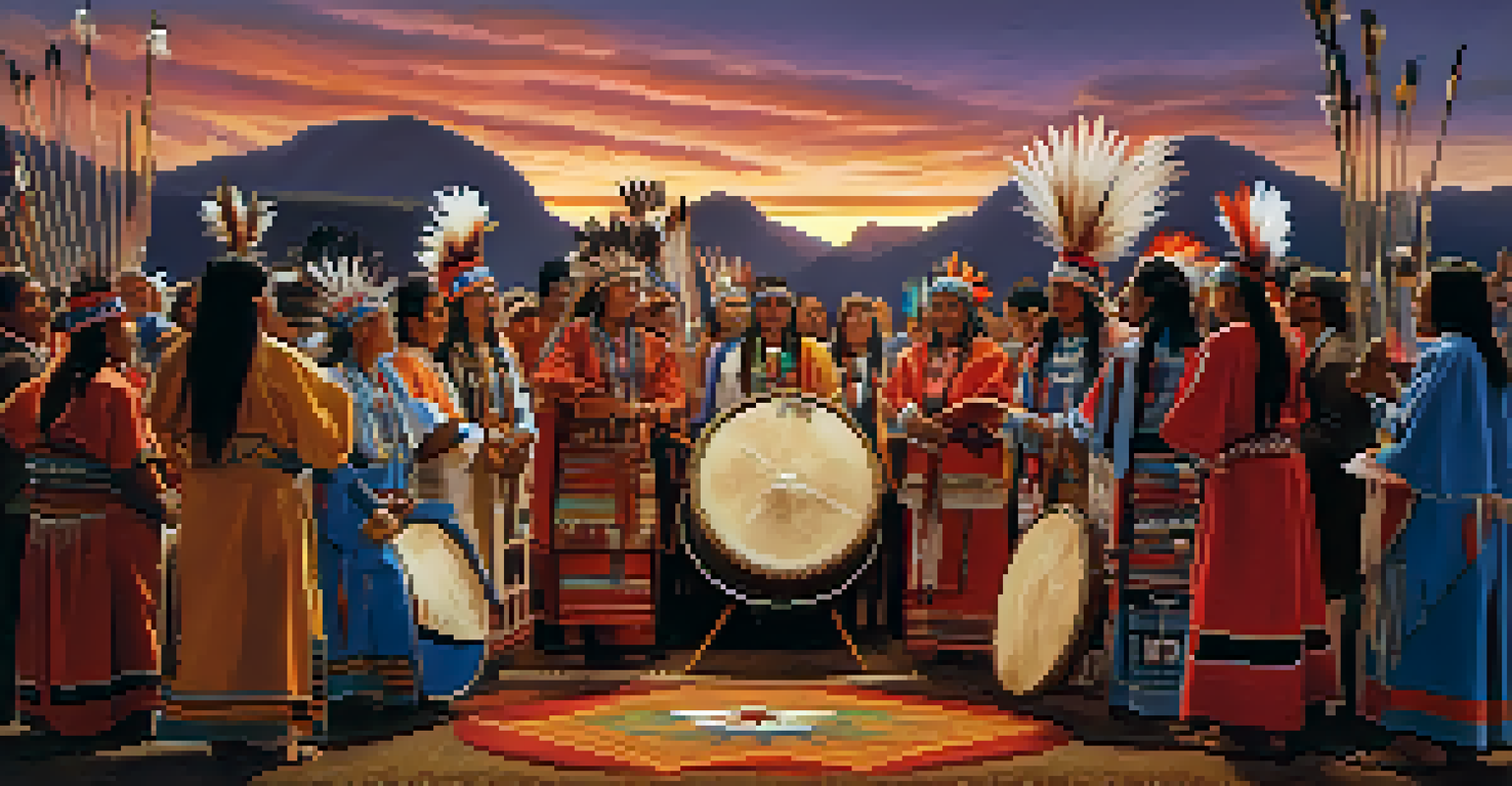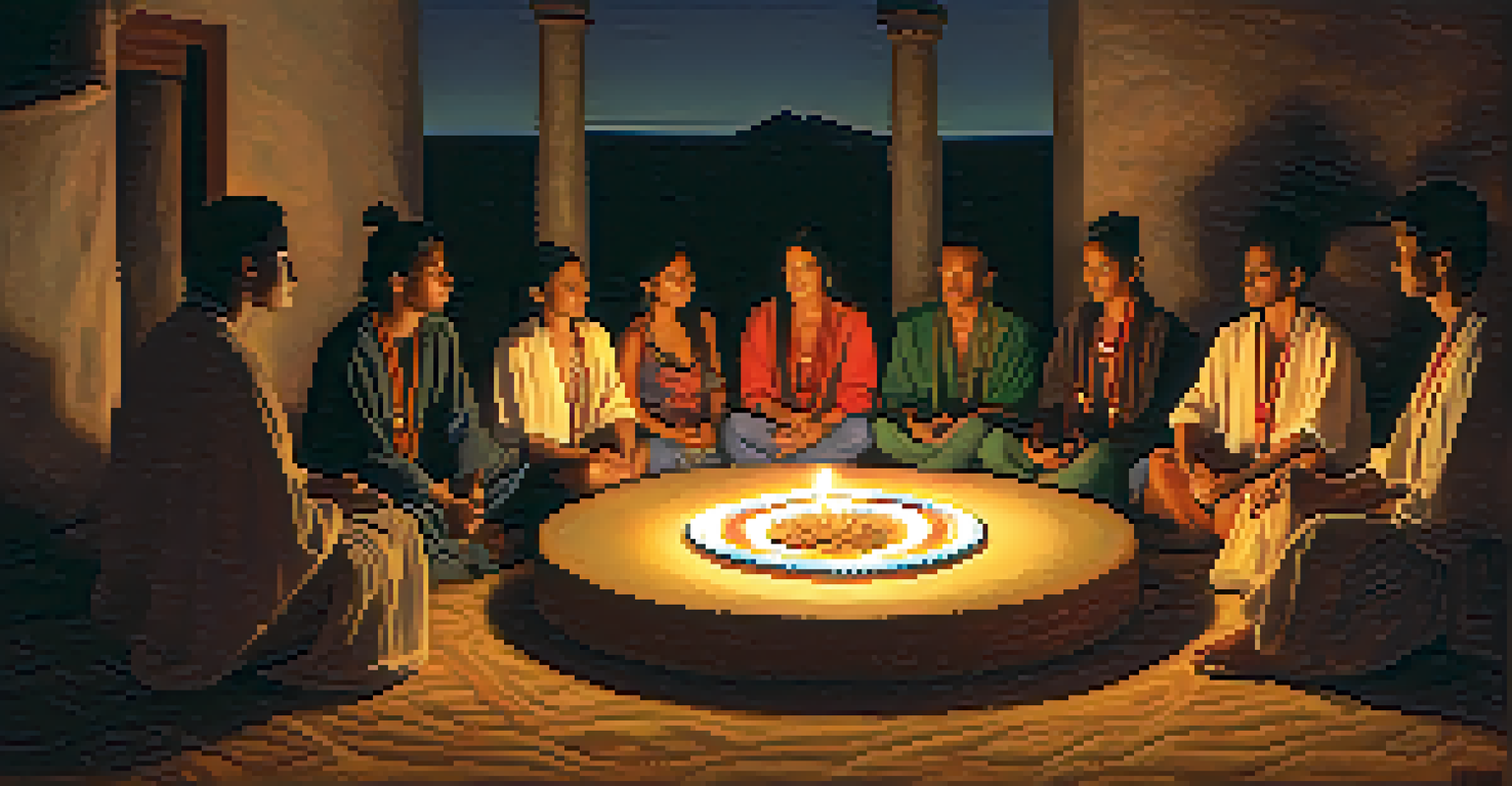Peyote's Influence on Native American Music and Dance Rituals

Understanding Peyote and Its Cultural Significance
Peyote, a small cactus native to North America, has been used for centuries by various Native American tribes, particularly in spiritual and ceremonial contexts. This plant is revered not just for its psychoactive properties but also for its deep-rooted significance in cultural identity. It's often seen as a bridge between the physical and spiritual worlds, fostering a sense of connection among participants during rituals.
The use of peyote in ceremonies is often linked to the Native American Church, where it plays a pivotal role in promoting healing and community bonding.
The use of peyote in ceremonies is often linked to the Native American Church, where it plays a pivotal role in promoting healing and community bonding. During these gatherings, participants consume peyote to achieve altered states of consciousness, which are believed to enhance their spiritual experiences. This aspect of peyote use reflects a broader understanding of spirituality among Native Americans, where nature and its elements are intertwined with their beliefs.
In essence, peyote is not merely a substance; it's a symbol of heritage and spiritual connection. Its influence extends beyond individual experiences to shape communal practices, making it a vital component of many Native American traditions.
The Role of Music in Peyote Ceremonies
Music is a fundamental aspect of peyote ceremonies, serving as a medium for expression and connection. Participants often sing traditional songs that have been passed down through generations, creating an atmosphere of unity and reverence. These songs are typically infused with themes of nature, spirituality, and community, reflecting the core values of Native American culture.

In addition to vocalizations, various instruments are used, such as drums and flutes, which contribute to the rhythmic and melodic elements of the ceremony. The drum, in particular, holds significant importance, symbolizing the heartbeat of Mother Earth and guiding participants through their spiritual journey. This musical accompaniment not only enhances the experience but also helps to synchronize the participants' energies during the ritual.
Peyote's Spiritual Role in Culture
Peyote serves as a vital cultural symbol for Native American tribes, facilitating spiritual connection and community bonding during rituals.
Overall, music acts as a powerful catalyst in peyote ceremonies, promoting healing and offering a shared space for spiritual exploration. The blending of song and peyote creates a unique atmosphere where individuals can connect with both themselves and their community.
Dance as an Expression of Spiritual Connection
Dance is another integral component of peyote rituals, providing a physical manifestation of spiritual beliefs. Participants engage in various forms of dance, often characterized by repetitive movements that reflect the rhythms of the accompanying music. This form of expression allows individuals to embody their spirituality and connect with the divine.
Cultural preservation plays a critical role in maintaining the integrity of peyote rituals and their associated music and dance.
The dances performed during peyote ceremonies are often symbolic, representing elements of nature, ancestors, and spiritual journeys. These movements serve to honor the sacredness of the ritual while also promoting a sense of collective identity among participants. Through dance, individuals can release their emotions and connect with the energy of the community, reinforcing their cultural ties.
In essence, dance transcends mere physical activity; it becomes a sacred practice that embodies the spirit of the ceremony. This dynamic interplay between music and dance fosters a deeper understanding of the spiritual significance of peyote in Native American traditions.
The Healing Power of Peyote Rituals
Peyote rituals are often seen as a source of healing for individuals and communities alike. The combination of music, dance, and spiritual reflection creates a holistic experience that addresses mental, emotional, and spiritual well-being. Many participants report feelings of clarity, peace, and connection following these ceremonies, highlighting the therapeutic potential of peyote.
Moreover, these rituals can facilitate discussions about personal struggles, allowing participants to share their experiences in a supportive environment. The communal aspect of peyote ceremonies fosters a sense of belonging, which can be especially beneficial for those facing challenges such as addiction or grief. This collective healing process is rooted in the understanding that individual growth contributes to the overall health of the community.
Healing through Music and Dance
The integration of music and dance in peyote ceremonies fosters healing and emotional expression, promoting a sense of belonging among participants.
Ultimately, peyote rituals exemplify the power of traditional practices in promoting wellness. Through the integration of music, dance, and shared experiences, these ceremonies provide a pathway for healing and transformation.
Contemporary Perspectives on Peyote Use
In recent years, the use of peyote has gained attention beyond Native American communities, sparking discussions surrounding its legal status and ethical considerations. While many advocate for its use in spiritual and therapeutic contexts, it's crucial to respect the traditions and rights of Indigenous peoples. The cultural significance of peyote is deeply rooted in a history that must not be overlooked.
Contemporary Native American groups emphasize the importance of preserving peyote's traditional uses while navigating modern challenges. This includes addressing issues such as the sustainability of peyote populations and ensuring that ceremonies remain authentic and meaningful. Engaging in dialogue about peyote within a contemporary framework can help bridge gaps between Indigenous and non-Indigenous perspectives.
As awareness of the spiritual and healing properties of peyote spreads, it's vital to approach its use with respect and understanding. Recognizing the cultural heritage of peyote can lead to a more profound appreciation of its role in Native American music and dance rituals.
The Importance of Cultural Preservation
Cultural preservation plays a critical role in maintaining the integrity of peyote rituals and their associated music and dance. As globalization and modernization continue to influence traditional practices, Native American communities are actively working to safeguard their cultural heritage. This includes passing down songs, dances, and rituals to younger generations, ensuring that the significance of peyote remains alive.
Efforts to preserve cultural practices often involve community gatherings, workshops, and educational programs that promote understanding and appreciation of Native American traditions. By engaging younger members of the community, these initiatives foster a sense of pride and responsibility toward their heritage. This collective effort reinforces the importance of peyote as a spiritual and cultural symbol.
Cultural Preservation Efforts
Native American communities are actively working to preserve the traditional uses of peyote and its associated rituals in the face of modernization.
Ultimately, cultural preservation is not just about maintaining the past; it also shapes the future. By nurturing their traditions, Native American communities can continue to celebrate the role of peyote in their music and dance rituals for generations to come.
Conclusion: The Enduring Legacy of Peyote
Peyote's influence on Native American music and dance rituals is profound and enduring. As a sacred plant, it serves as a catalyst for spiritual connection, healing, and cultural expression. The interplay of music and dance during ceremonies creates a unique experience that embodies the rich traditions of Native American communities.
As we navigate contemporary discussions surrounding peyote, it's essential to honor its cultural significance and the rights of Indigenous peoples. The legacy of peyote is intertwined with the history, spirituality, and artistry of Native American traditions, making it a vital component of cultural identity.

In appreciating the role of peyote in music and dance rituals, we not only celebrate a rich heritage but also contribute to a broader understanding of the diverse ways in which spirituality can manifest in human experience.